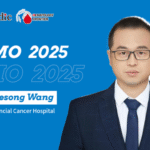
The European Society for Medical Oncology (ESMO) Congress 2025 was grandly held in Berlin, marking another wave of scientific innovation across the field of oncology.In hematology, several exciting advances drew attention—from uncovering the mechanisms of CAR-T resistance and exploring dual-target immunotherapies, to studies on precision treatment discontinuation in multiple myeloma and single-cell immune atlas mapping that deepens our understanding of hematologic malignancies. Together, these studies highlight continuous innovation in medical science and bring new hope for improving diagnosis and treatment in hematologic diseases.To further focus on major breakthroughs in hematology and foster academic exchange, Oncology Frontier – Hematology News invited Dr. Sicong Zhang, from Professor Huilai Zhang’s research group at Tianjin Medical University Cancer Institute and Hospital, to discuss the innovation and clinical significance of a new study presented at ESMO 2025, as well as to share his insights into future trends in the field. Abstract 1246MO: A Single-Cell Circulating Immune Atlas Reveals Shared Immune Features Associated with Response to R-CHOP and Anti-CD19 CAR-T Therapy in DLBCL
Q1
This study found specific peripheral immune dysregulation in patients with primary refractory diffuse large B-cell lymphoma (DLBCL), and a machine learning model successfully distinguished refractory patients from responders using three key immune features. What do these immune characteristics reveal about the interaction between the tumor microenvironment and the peripheral immune system? Could future therapeutic interventions targeting key immune subsets—such as regulatory T cells (Tregs) or TFH1 cells—help overcome treatment resistance?
Dr. Sicong Zhang:Because the tumor immune microenvironment and the systemic immune system are interconnected through vascular and lymphatic circulation, tumor burden can induce global immune remodeling. In this study, we observed that refractory DLBCL patients exhibited systemic immune dysregulation characterized by increased levels of CXCR5⁺CXCR3⁺HLA-DRhi PD-1hi CD127⁻ follicular helper T-cell type 1 (TFH1) cells, classical monocytes, and Tregs. These changes reflect the tumor’s capacity to reshape both local and systemic immune ecosystems.
Under chronic antigenic stimulation and persistent inflammation, the systemic immune milieu becomes increasingly suppressive—manifested as abnormal TFH1 activation, disrupted germinal center responses, and expansion of monocytes and Tregs. These immunosuppressive populations may be recruited into the tumor microenvironment, jointly constructing an immunoregulatory network that supports tumor persistence.Therapeutic strategies tailored to such immune profiles hold potential clinical value. For example, patients exhibiting high-risk immune signatures may respond poorly to standard R-CHOP chemotherapy but could benefit from intensified regimens or combinatorial immunotherapy approaches.
Q2
The study observed distinct and overlapping patterns of immune homeostasis restoration following CAR-T therapy—for instance, a sustained expansion of CXCR3⁺CD4⁺ Th1 cells up to day 365, whereas terminally differentiated CD8⁺ TEMRA cells peaked at day 90 before declining. How do you interpret these dynamic immune changes in relation to treatment efficacy? Do these findings suggest that prolonged activation or exhaustion of specific immune subsets may influence the durability of CAR-T responses?
Dr. Sicong Zhang:The dynamic immune changes before and after CAR-T therapy highlight a close link between immune system reconstitution and clinical outcomes. Persistent expansion of CXCR3⁺CD4⁺ Th1 cells likely reflects sustained CAR-T-induced Th1-type antitumor immunity. Notably, patients with longer progression-free survival (PFS) demonstrated greater Th1 expansion, suggesting that this subset may serve as a positive biomarker of immune recovery.
Meanwhile, CD8⁺ TEMRA cells—terminally differentiated effector memory T cells—peaked around day 90 and then declined, possibly indicating a natural transition from a strong effector phase back to immune homeostasis. After exerting their cytotoxic function, effector CD8⁺ T cells tend to enter states of terminal differentiation and exhaustion.
Overall, persistent activation or exhaustion of specific immune subsets clearly impacts the durability of CAR-T efficacy. Sustained Th1 activation contributes to immune memory formation, but concurrent elevation of high-risk immune signatures—such as PD-1hi HLA-DRhi CD127⁻ TFH1 cells and expanded classical monocytes and Tregs—may predict inferior responses. Previous studies have shown that classical monocytes co-expressing T-cell inhibitory molecules can suppress T-cell activation and promote exhaustion, which is consistent with our findings.
Q3
The study proposed that peripheral immune signatures could serve as liquid biomarkers to predict and monitor treatment response. However, standardization of single-cell flow cytometry and machine learning models remains challenging. How can these technologies be optimized and made widely accessible in clinical practice?
Dr. Sicong Zhang: In this study, we utilized high-dimensional spectral flow cytometry covering 22 surface markers, combined with FlowSOM and UMAP clustering algorithms, to construct a circulating immune atlas. Using random forest modeling, we identified key immune features predictive of treatment outcomes.
To facilitate clinical translation, we aim to establish a simplified and standardized multicolor flow cytometry workflow—reducing the panel to 10–15 essential markers, while unifying sample handling, antibody titration, quality control, and data analysis. This will enable development of a reproducible peripheral immune scoring system. Nevertheless, since our current results derive from single-center analyses, multi-center validation with larger cohorts is needed to ensure standardization and generalizability.
Based on both tumor immunology and our findings, we propose that the following patient groups should be prioritized for peripheral immune profiling:
1. Newly diagnosed high-risk DLBCL patients (IPI ≥2 or significantly elevated LDH). Early profiling can identify refractory tendencies and support timely treatment intensification.
2. Relapsed/refractory DLBCL patients receiving CAR-T therapy, as baseline immune states affect CAR-T expansion and persistence.
3. Elderly patients with immune senescence, where immune profiling can inform the need for immunomodulatory interventions.
In clinical practice, immune phenotyping can be integrated with PET-CT and other conventional assessments to guide precision treatment. Moreover, longitudinal monitoring of circulating immune biomarkers may allow early detection of relapse risk. Patients with high-risk immune signatures, as defined in this study, could potentially benefit from enhanced preconditioning or combination therapy with immunomodulators.
Summary
Dr. Zhang’s insights highlight the growing role of immune phenotyping and computational modeling in precision hematologic oncology. These approaches may soon enable clinicians to anticipate treatment resistance and tailor immunotherapy strategies for patients with refractory DLBCL, ultimately improving long-term survival and quality of life.


